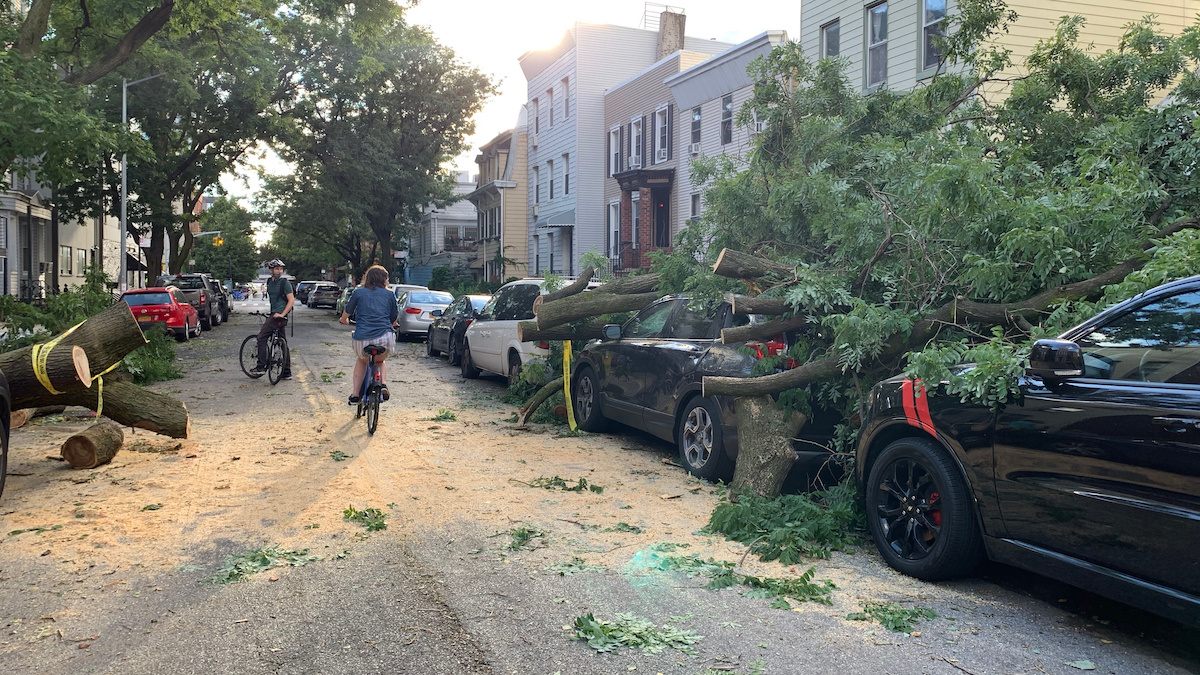

Bicyclists pass a fallen tree in the Greenpoint area of Brooklyn, New York on Aug. 4, 2020 after Isaias left hundreds of thousands without power and prompted flood precautions in New York City. DIANE DESOBEAU / AFP via Getty Images
At least six people are dead after Isaias sped up the East Coast Tuesday, downing trees, spawning tornadoes, and flooding homes and roadways as it went.
The earliest “I” storm of an Atlantic hurricane season on record began its path of destruction late Monday night when it made landfall as a Category 1 hurricane in Ocean Isle Beach, North Carolina. It brought both flames and floods, causing at least five structures to catch fire, The New York Times reported.
“We didn’t think it was going to get to this level,” Morgan Strenk, who offered a family shelter from the flames in her vacation home even as its basement filled with three feet of water, told The New York Times.
At approximately 11:40 p.m., there were reports of multiple structure fires in the area of Ocean Isle Beach, North Carolina.
Horry County Fire Rescue is providing multiple units to help in response.#HCFR pic.twitter.com/L6cqjO6j9T
— Horry SC Fire Rescue (@hcfirerescue) August 4, 2020
The hurricane also brought storm surge flooding to Oak Island, North Carolina and rose the Cape Fear River in Wilmington, North Carolina to a record high level, The Weather Channel reported.
Isaias weakened to a tropical storm over Eastern North Carolina early Tuesday morning, according to the National Hurricane Center (NHC). But it was still a deadly force as it moved up the East Coast.
One of the major hazards was falling trees, which killed at least three people in New York, Delaware and Maryland, according to CNN. Trees fell from Virginia to New England, and more than three million homes and businesses lost power, The Weather Channel reported.
Haven’t seen tree damage this extensive since Sandy in Woodbridge, NJ. You can actually smell the trees. No power. #NJwx #Isaias @JimCantore @JenCarfagno @StephanieAbrams @wxnewsdesk @RadarOmega_WX @spann @StormHour @epawawx @nynjpaweather @News12NJ @DaveCurren @JaniceHuff4ny pic.twitter.com/rXZtASkBA1
— Collin Gross (@CollinGrossWx) August 4, 2020
Another major hazard was tornadoes. The National Weather Service received more than 20 reports of twisters between North Carolina and Pennsylvania.
In one tragic incident, 12 people were injured and at least two people were killed when a tornado hit a mobile home park in Windsor, North Carolina, CNN reported.
“We didn’t have a lot of time to react once it finally hit. I mean, it hit all at once,” resident Desaree Pike told CNN affiliate WRAL. “For lack of a better word, it was hell. You don’t really think about anything else but just holding the kids and hoping it doesn’t tear the house up.”
Mobile home ripped from its foundation on Woodard Rd. near #Windsor in Bertie County. This damage is about two miles from Morning Rd., where a tornado destroyed 10 mobile homes and killed 2 people overnight. Morning Rd. is still shut down to traffic. #wral pic.twitter.com/n6679pqqUJ
— Joe Fisher – WRAL (@JoeFisherTV) August 4, 2020
One of the reasons Isaias was so dangerous, and spawned so many tornadoes without warning, was the speed at which it moved. As of Tuesday evening, it was still moving 40 miles per hour and still had maximum sustained winds of 50 miles per hour.
In addition to wind, the storm also brought widespread flooding.
As of 6PM Tuesday, we are forecasting flooding at 14 locations across the Mid-Atlantic region. Please follow the latest forecasts at https://t.co/47CQ6yEqJn pic.twitter.com/hS3rV1nbMA
— NWS MARFC (@NWSMARFC) August 4, 2020
Pennsylvania was especially inundated. One person died in the state when floodwaters swept away their vehicle, CBS News reported. Little Lehigh Creek and Perkiomen Creek in Pennsylvania both crested at record levels and Darby Creek flooded a neighborhood in southwest Philadelphia, according to The Weather Channel.
**Breaking – Darby Creek floods its banks into Southwest Philadelphia neighborhood near 84th St and Lindberg Blvd. Numerous rescue taking place at this time. #Isiais @6abc pic.twitter.com/zmoqWlGyrj
— Dan Patrick (@6abcDan) August 4, 2020
A man and woman also had to be rescued in In Charles County, Maryland after flood waters swept their cars off the road, CBS News reported.
However, the storm’s speed provided one advantage: It did not linger, which reduced river flooding and allowed emergency workers to respond rapidly, The New York Times reported.
“All in all, this storm got in, got out pretty quickly,” North Carolina Gov. Roy Cooper told “Good Morning America” on Tuesday, as The New York Times reported.
He said this meant the damage was “not as great as it could have been.”
The storm has now moved into Canada as a post-tropical cyclone, according to a 5 a.m. EDT update from the NHC. It is currently about 55 miles northwest of Quebec City and is expected to dissipate over southeastern Canada Thursday.
But as the storm fades, it leaves a sobering reminder of what a future shaped by the climate crisis could look like, The New York Times pointed out. Isaias struck the same week that the Apple Fire forced thousands to evacuate in Southern California, and both disasters came as the nation still struggles to contain the coronavirus pandemic, giving a foretaste of the overlapping crises we can expect if the climate continues to destabilize.
“State and local governments already stretched with Covid responses must now stretch even further,” adaptation program director at the Georgetown Climate Center in Washington Lisa Anne Hamilton told The New York Times. She said better planning was needed to prepare for the disasters to come.
- Covering the 2020 Elections as a Climate Story - EcoWatch
- NASA Forecast: Conditions Ripe for North Atlantic Hurricanes and ...
- Atlantic Faces Fifth 'Above-Normal' Hurricane Season in a Row ...
- Hanna Pummels Texas as First Atlantic Hurricane of 2020 and ...

 233k
233k  41k
41k  Subscribe
Subscribe 